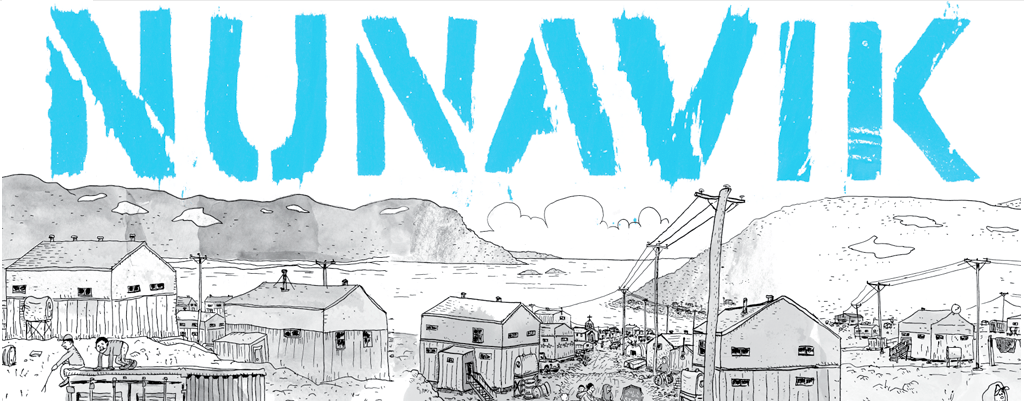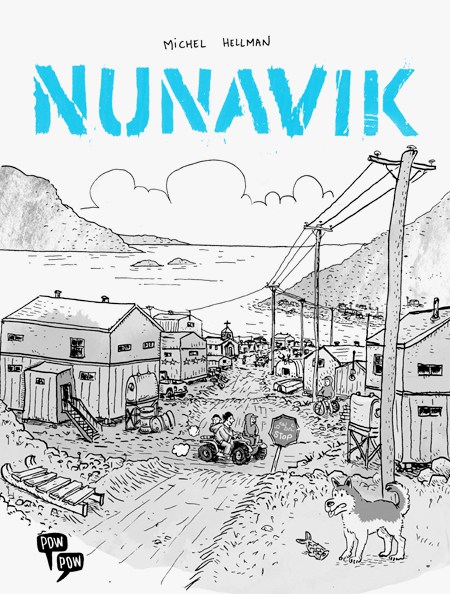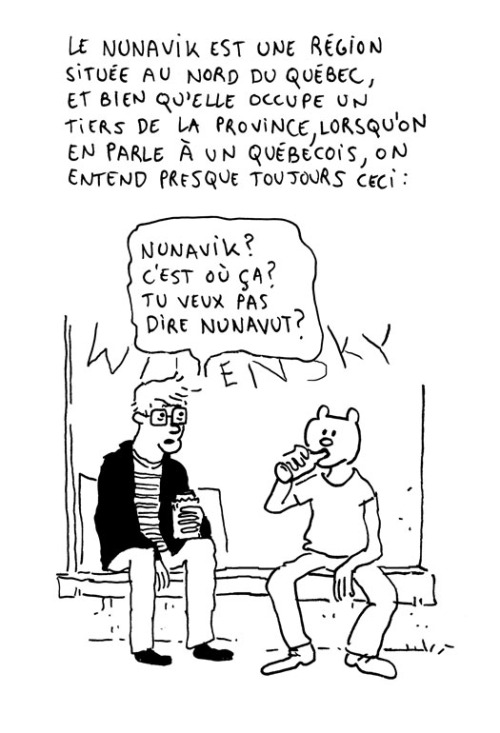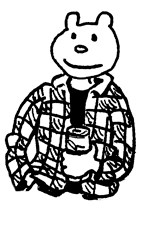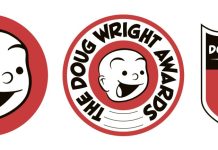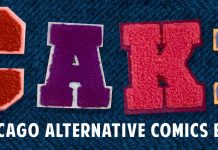The Toronto Comic Arts Festival is one of the most influential and important comic book event in North America. It’s mission is to “promote the creators of comic books in their broad and diverse voices, for the betterment of the medium of comics”. In the spirit of this mission, the Comics Beat has conducted a series of interview with some of the phenomenal cartoonists in attendance at this year’s festival. The Comics Beat will be releasing a series of interview with cartoonist in attendance. We hope that these interviews will improve our understanding of these creators voices, techniques, interests and influences.
Michel Hellman is a cartoonist from Montreal who lives in the Mile End. He loves his neighbourhood so much that he wrote a graphic novel on it. In his latest graphic novel, Michel Hellman sets his sight on the Nunavik, as he explores the northern region of Quebec, it’s appeal, it’s challenge. It’s a fascinating look at one of the lesser known region of the province of Quebec and one to which Michel has been drawn to many times. I’ve spoken with him about his new comic, his experience in the North and the upcoming translation of his graphic novel.
—
Philippe Leblanc: For those readers who may not be familiar with you and your work, can you tell us a little bit about yourself?
Michel Hellman: I’m a comic book author, illustrator, and visual artist living in Montreal. Nunavik is my fourth graphic novel. I mostly do auto-fiction, but also some experimental comic books that includes collage and various other techniques.
PL: You have already worked on two other graphic novels about the Canadian North (Iceberg and Petit guide du plan Nord). Nunavik is your third tale on this subject and the first published in English. What attracts you to those northern territories?
MH: I’ve been attracted by the North ever since I was young. I was going on long canoe-camping expedition with my family and that gave me a thirst for open spaces. It intrigued me and awoken my curiosity to see what was up further, in the arctic. The North has a mythical dimension for me; it’s the last frontier, it’s freedom, but it’s also a challenge, a way to push your own boundaries. In my first trip there in 2008, I fell in love with this environment and the Inuit culture I discovered.
PL : I’m very interested in the genesis of Nunavik. You begin Nunavik with a conversation with your publisher Luc Bossé (of Pow Pow Press) as he is asking you the status of the graphic novel you were supposed to be working on (Mile End 2). You are avoiding clear answers on your progress. When you decide to go in Nunavik for a few weeks, you leave your family, your wife and newborn child. I was surprised that you were so honest with the book. Was the call of the North stronger than that of the responsibilities you were facing in Montreal? How did you reconcile this urge to go and your family?
MH: I think to understand Nunavik, you have to realize that while it is based on my experiences in the arctic, there is a part of exaggeration and auto-fiction. The story is based on two trips I made in Nunavik in 2008 and 2015. I wanted to talk about the Quebec North for a long time and it’s really my publisher who pushed me to do so (the exact opposite of what I portray in the graphic novel)! With regards to my wife, she was really supportive throughout this project… but it’s not what I portray in this comic!
I chose to play with the truth by juxtaposing two locations, Montreal’s Mile End and Nunavik. I wanted to reinforce the contrast between those two worlds that coexists in the same province: the Mile End, a hip, urban neighbourhood, symbol of fads, fashion, gentrification and superficial luxury and on the other end, the Nunavik, a wide unknown and isolated territory whose conditions often resemble those of third world country.
It’s also why the narrator is full of contradiction. He has a very privileged way of life yet complains about “turning in circle”. He’s going to look for adventure and inspiration, but it will also be a pretext to flee from his newfound family obligations. He’s confronted with his own navel-gazing attitude during his trip. There is a part of documentary on the North, but there’s also a big part of self-discovery in this graphic novel.
PL: You are going to meet with communities, nature and the landscape with an open mind and enthusiasm for discovery. How did you determine which elements needed to be kept to be able to fully illustrate your experience?
MH : During my first trip in the Nunavik in 2008, I was floored by what I saw. It was a real culture shock, but I also fell in love with the region and it’s environment. I knew from the first trip that I wanted to make a graphic novel. I didn’t feel I had enough material, enough knowledge to explore such a sensitive topic. I started reading extensively on the North and I familiarized myself with the issues facing Inuits. I also contacted people who moved there to understand another aspect of life in the Nunavik.
I went back for another more “In-depth” trip during which I had the chance to spend more time in northern communities. For the graphic novel, I wanted to convey my enthusiasm, my fascination and my first impressions without falling in a trap full of naivety and rose-coloured glasses. It was important that I talk about the negatives aspects that are also a part of life in the North. I wanted to give an account as close to possible of my experiences with ever pretending I was an expert on the subject.
PL : In the book, we sense you have spent a tough time during these trips. You left Montreal with an enthusiasm that disappears slowly during your trip. What was the thing that surprised or affected you the most during those trips?
MH : Well, the enthusiasm remains there, but it is replaced by something more profound that comes from an understanding of the realities of the region. After an initial “honeymoon phase”, people who go up there often feel homesick and question themselves while facing such a different culture and environment. It’s a phase you have to go through to open up and learn how to appreciate the “true North” (Which isn’t a given for everyone). I talk about this in the chapter “Puvurnituq” which describes feeling suffocated, discouraged and powerlessness that people sometimes feel in those isolated communities in which the population are facing such difficult social issues. Traces of this violence, whether direct or indirect, that you see in the North naturally affects travellers, but what really struck me, was this profound resilience, pride and strength of the Inuit who succeeds, in spite of massive challenges facing them today, to do what they’ve done, as they’ve done for thousands of years in one of the most harsh environment on the planet: Use their ingeniosity to adapt and survive.
PL: Nunavik was published in English through Pow Pow Press. Your biography indicates that your mother was French and your father American. Was it important for you to see this graphic novel being published in English?
MH: Yes, I’d like to reach an English audience. Especially since English is the most spoken language in Nunavik. The original edition has a lot of English dialog thatt wasn’t translated or subtitled to remain as realistic as possible.
PL : What do you want your readers to take with them once they’ve read Nunavik?
MH : I would like them to learn the same lessons I’ve learned, that prejudice and preconceptions are persistent, even when we’re convinced we have an open mind. We have to go and meet . I realized in the end I knew nothing about Inuit culture, nor any other indigenous people in Canada, I’m sure I’m not the only one either! Respect, understanding of others begin with an open mind and curiosity. If I inspired my readers to discover this enormous richness that exists in the North, I’d be really happy!
PL: Can we expect to see the sequel to Mile End this year or will you be focusing on another region in Quebec?
MH: I can’t say anything for the moment! Though I don’t think I’ll do a full sequel to Mile End (at least not in that format) but you never know!
—
You can follow Michel Hellman over at his blog Life in a Panel, You can get Nunavik and Mile End over at the Pow Pow Press store.
Come and meet Michel at TCAF, he’s eager to learn more about your culture.


